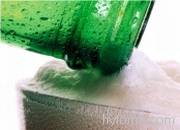 download article
download articleBeer
Article index
 | Ingredients required for brewing | |
 | Sugar source | |
 | Hops | |
 | Hops are used in three basic forms: | |
 | Yeast | |
 | Two types of yeast | |
 | Water | |
 | Complex processing | |
 | Bottled or kegged? | |
 | Top beer markets |
Even the ancient Egyptians appreciated the outstanding properties of beer.
Since no micro-organisms grow in beer, it can be stored for a long period of time. Other cultures fermented wine for the very same reasons. Fermentation is the keyword in this respect. In addition to carbon dioxide and some spices, alcohol is responsible to a large extent for the storing quality of beer. The conductivity of beer ranges between 1.2 and 2.3 mS/cm.
Brewers have adapted to the raw materials available in individual regions over the past few millennia. This clearly demonstrates the versatility of beer.
Ingredients required for brewing
The following ingredients are normally required to brew beer:Sugar source
Selection influences alcohol content and taste of the end productA sugar source (see also Malting) which ideally contains enzymes in order to break down the starch molecules into small pieces (monosaccharides). This may be any type of grain, but also theoretically any other fruit. The grain can be used in malted form or as a raw fruit. Barley malt is normally used, but wheat or other types of grain can also be utilized for regional products. Rice and maize are used primarily as raw fruits, i.e. as un-malted sources of starch. Industrial sugar sources are also used at times.
The sugar content in a wort is measured according to the Plato scale and is called the original wort. The decisive factor here is the density, i.e. the ratio of the weight. When the wort is produced, the possible alcohol content and the taste of the end product are predetermined by defining the amount of sugar available.
Hops
The most expensive raw material in brewing gives beer its bitter taste
Spices have been used throughout the centuries since the ancient Egyptians. However, this is not true of hops. Evidence proves that hops have only been used to brew beer for around 1,000 years. Prior to this, every possible herb was used. Hops give beer its bitter taste and also produce an aseptic effect. The bitterness of beer differs depending on the individual type. The alpha acid content is the constituent of hops which gives beer its bitter taste. A distinction is made between bitter hops and aroma hops. Hops are primarily grown in Germany (Hallertau, Tettnang), the Czech Republic (Saaz) and the USA. Hops are a tendril plant and need special soils. Their cultivation is very expensive. Only the fruits of the female hop plants can be used.
Hops are the most expensive raw material used in beer brewing. However, only a few hundred grams per 100 liters must be used.
An other property of hops is that it forms a complex with protein. Due to the complex forming a part of the protein (because the proteincontent is too high) can easily be removed by filtration.
Hops are used in three basic forms:
- Natural hops according to how they were picked
- Hop pellets, i.e. cleaned and partially freed bitterns from leaves with different concentrations Hop extracts have become established as the
- final development, especially in fully automatic brewing houses. Hop extracts are highly viscous and must be dissolved in hot water prior to use. They can then be apportioned fully automatically. Hops are added to the copper processor, often in several batches (doses) during different phases in the cooking process.
Hops must also be cooked in order to release their bitterns through isomerization. However, some of the bitterns are also destroyed again through long cooking. It is possible to use isomerized hop extracts. They can be added shortly before the end of the cooking process.
Today different aromas are used to brew beers with a regional character.
Yeast
Different range of produced esters affects the taste
After a bitter sugar water has been prepared in the brewing house, yeast is used. Yeast is a single-cell micro-organism which can absorb simple sugars and turn them into carbon dioxide and alcohol. The yeast passes through two stages.
It multiplies through division as long as oxygen is available. The metabolic process, i.e. alcoholic fermentation, starts once the oxygen is used up. Fermentation continues until no sugar is left. The yeast produces alcohol, carbon dioxide and heat during this process. Since the yeast can only metabolize simple sugars, special importance is attached to mashing.
Beer yeast is a special cultivation which is re-cultivated in many breweries as their own culture. It determines the taste of the beer due to the different range of esters that are produced. A sufficient number of new fresh yeast cells are produced in so-called pure culture units. Basic hygienic rules must be observed very closely during the operation of these units to prevent the yeast suspension from being infected by foreign organisms.
Two types of yeast
A distinction is made between two basic types of yeast:- Top-fermenting yeast which floats at the end of traditional open fermentation on top of the green beer
- Bottom-fermenting yeast which sinks to the bottom at the end of a fermentation cycle.
Some of these cells die off and are removed from the process. The other cells are reused for the next batch after harvesting. Bottom-fermenting yeast can be used for up to 15 cycles. In principle, there is no limit for top-fermenting yeast. 2,500 runs with a yeast batch are not uncommon.
Water
Hardness is decisive for the type of beer
Water plays an important role for the grain enzymes and yeast. The hardness of the water determined the type of beer in the past. Prior to the use of water softening plants, it was not possible to brew all types of beer everywhere. Every required level of hardness can now be set. Therefore it is possible to brew a beer brand with almost the same taste consistency at many locations throughout the world.
Complex processing
The wort from the brewing house (production time = approx. 12 hours) is fermented in the fermentation cellar (5 to 7 days) at a temperature ranging between 12°C and 20°C and is then placed in cold storage to mature (8 to 24 days at a temperature of up to -2°C after yeast harvesting . The yeast can also carry on metabolizing higher alcohols formed during the turbulent fermentation phase. This process is very important for the taste formation and stability of the beers. Secondary fermentation is influenced by the temperature and the amount of time available.The finished beer is then freed from all yeast cells and protein precipitations by means of filtration and is then ready for bottling in the pressure tank cellar. The proteins stem from the grain and are responsible, for example, for the froth. Since the proteins cause turbidities when their proportion is too high, some of them are removed.
Most of the internationally brewed beers are still filtered via diatomite pre-coat filters – membrane filtration techniques are still in the development phase. Biological safety can be guaranteed by means of sterile or trap filters. The finished filtered beer now remains in the pressure tank cellar for bottling.
Before the beer is bottled or filled in closed barrels, it is subjected to heat treatment in order to kill off any existing micro-organisms. Short-time heating systems or tunnel pasteurizers are used for this purpose.
Bottled or kegged?
Most of the beer produced worldwide is filled in disposable or reusable bottles. Glass is still used primarily for beer bottles although PET bottles are slowly gaining acceptance. Cans are also in widespread use.Keg beer accounts for between 15% and 20%, but fluctuates strongly depending on the individual country.
Top beer markets
Beer is measured in hectoliters in the countries which use the metric system. 1 hectoliter is equivalent to 100 liters. Otherwise, tonnes or barrels are widespread. The top 50 beer brewing countries in the world produce a total of around 1.5 billion hectoliters, i.e. 95% of the world beer market. The beer markets in the top 20 countries are as follows (position in 2004):
| Land | Population (Million) | Beer production (Million hl) |
| China | 1294.0 | 254.0 |
| USA | 291.0 | 232.2 |
| Germany | 82.4 | 106.3 |
| Brazil | 176.3 | 82.2 |
| Russia | 144.1 | 73.2 |
| Mexico | 102.0 | 66.4 |
| Japan | 127.5 | 65.0 |
| UK | 59.1 | 58.0 |
| Spain | 41.0 | 30.7 |
| Poland | 38.6 | 27.3 |
| South Africa | 44.0 | 25.2 |
| Netherlands | 16.0 | 25.1 |
| Canada | 31.0 | 23.4 |
| South Korea | 47.8 | 19.8 |
| Czech Republic |
10.2 | 18.6 |
| France | 59.4 | 18.1 |
| Australia | 19.3 | 17.3 |
| Ukraine | 48.9 | 16.6 |
| Belgium | 10.3 | 15.7 |
| Thailand | 62.2 | 15.2 |
An analysis of the individual countries reveals different per capita consumption levels for beer.
In western industrial nations per capita beer consumption is much higher than in countries where industrialization is not yet so advanced. This is due on the one hand to the available income, but also to difficult logistics.
The Czech Republic, Belgium, Germany and Ireland, i.e. traditional European countries, top the league table for per capita beer consumption. However, high rates of increase are currently being achieved in Asia.
The world beer type does not exist. However, light end-fermented beers brewed using bottom-fermenting yeast have become established on the international market. In addition to the large internationally operating brewing groups, regional specialties are also continually gaining more acceptance. This underscores the saying "beer needs a home".
Click for additional information about Beer
 back to top
back to top








 companies
companies




